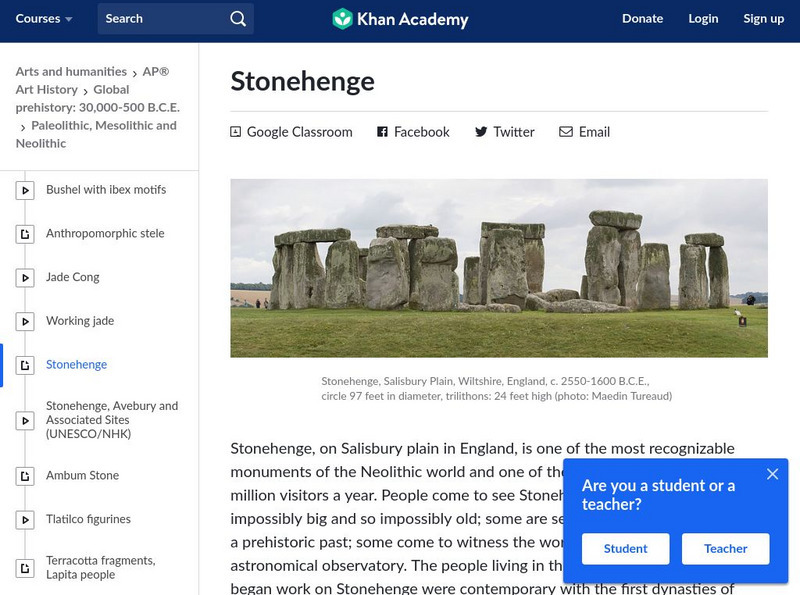Khan Academy
Khan Academy: Art History: Stonehenge, Salisbury Plain, England
Article discussing the construction and the significance of Stonehenge. Includes links to additional information, images, and an animation.
University of Toronto (Canada)
Canadian Painters as Art Educators 1920 1950
Interesting general discussion of Canadian art and artists between 1920-1950 that was a new generation of painters than before the First World War. Gives biographical information on a variety of different painters with examples of their...
Khan Academy
Khan Academy: About Chronological Periods in the Islamic World
Studying the Art of the Islamic world is challenging, partially because of the large geographic and chronological scope of Islam. In order to simplify the study of Islamic Art, it has been divided into chronological periods: Early,...
Khan Academy
Khan Academy: Fort Ancient Culture: Great Serpent Mound
The Great Serpent Mound in rural, southwestern Ohio is the largest serpent effigy in the world. Scholarly debate surrounds its use and exactly why it was built. But without a doubt, the mound is singular and significant in its ability to...
Khan Academy
Khan Academy: Crossroads of the Ancient World
Because of Afghanistan's geographical position -- on the edge of central Asia with India and China beyond to the east, and Iran, the Middle East and the numerous cultures of the Mediterranean and the rest of Europe to the west -- it was...
A&E Television
History.com: What Prehistoric Cave Paintings Reveal About Early Human Life
Some of the oldest known art may hint at the beginning of language development, while later examples portray narratives with human and animal figures. What does the oldest known art in the world tell us about the people who created it?...
Khan Academy
Khan Academy: Us History: 1491 1607: Spanish Conquistadores and Colonial Empire
The Spanish gained an early foothold in the colonies, quickly becoming the most powerful European power in the New World.
A&E Television
History.com: Ancient Egypt
For almost 30 centuries -- from its unification around 3100 B.C. to its conquest by Alexander the Great in 332 B.C. -- ancient Egypt was the preeminent civilization in the Mediterranean world. From the great pyramids of the Old Kingdom...
Khan Academy
Khan Academy: Velasco, the Valley of Mexico
"The Valley of Mexico from the Hillside of Santa Isabel" by Velasco represents an important period in the development of Mexico's national identity and an important chapter in the history of Mexican art. Velasco's landscapes became...
Khan Academy
Khan Academy: Apollo 11 Stones
The Apollo 11 Stones remain the oldest examples of figurative art from the African continent. Their discovery contributes to our conception of early humanity's creative attempts, before the invention of formal writing, to express their...
New York University
Institute for the Study of the Ancient World: Lost World of Old Europe
Exhibition of Neolithic statuettes, figurines, and vessels from Romania, Bulgaria, and Moldova answers a series of burning questions about early settlements along the Danube, dating from 5000 to 3500 B.C.
Other
Leather Puppets of India
Use this site to learn about the fascinating world of Gypsy-made leather puppets. This nomadic tribe is always on the move carrying their puppets and musical instruments seeking permission from village leaders to perform for monetary...
Other
Art History Worlds: Early River Valley Civilizations
Why did the first complex, politically centralized civilizations materialize along rivers? Find out here by taking a close look at the Nile River civilizations, Mesopotamia, the Harappan civilization and the Xia, the Shang, and the Zhou...
Metropolitan Museum of Art
Metropolitan Museum of Art: Trade Routes Between Europe & Asia During Antiquity
Long-distance trade played a major role in the cultural, religious, and artistic exchanges that took place between the major centers of civilization in Europe and Asia during antiquity. Some of these trade routes had been in use for...
Khan Academy
Khan Academy: Stonehenge
Stonehenge, on Salisbury plain in England, is one of the most recognizable monuments of the Neolithic world and one of the most popular, with over one million visitors a year. Construction of Stonehenge was a result of at least three...
Khan Academy
Khan Academy: Temple of Amun Re and the Hypostyle Hall, Karnak
The massive temple complex of Karnak was the principal religious center of the god Amun-Re in Thebes during the New Kingdom. The complex remains one of the largest religious complexes in the world. This temple gives scholars a wealth of...
Khan Academy
Khan Academy: Cultural Heritage "In Crisis"
Cultural heritage is in danger of destruction, looting, or illicit trafficking in many places around the world. This is not a new phenomenon. This essay examines the causes of cultural destruction and what can be done to save these...
Khan Academy
Khan Academy: The Historical Buddha
Among the founders of the world's major religions, the Buddha was the only teacher who did not claim to be other than an ordinary human being. Read about his life in this article.
Khan Academy
Khan Academy: Judaism, an Introduction
Judaism is a monotheistic religion that emerged with the Israelites in the Eastern Mediterranean. This short introductory article discusses the history of Judaism, its sacred texts, and Jewish law.
Khan Academy
Khan Academy: Principal Deities of Hinduism
There are many Hindu deities, some with great and others with limited powers. Most Hindus focus their devotion primarily on one of these, whom they regard as supreme. These deities are shown in a variety of art forms. This short article...
Khan Academy
Khan Academy: Cultural Heritage at Risk: Syria
Syria, home to some of the oldest and culturally rich cities and archaeological sites in the world, is currently experiencing significant devastation due to shelling, a breakdown of order, looting,and iconoclasm. The current situation in...
Khan Academy
Khan Academy: Cultural Heritage at Risk: Turkey
The modern state of Turkey is one of the most archeologically and culturally rich places in the world. This article discusses why these sites are endangered and the struggle to protect these sites.
Khan Academy
Khan Academy: Cultural Heritage at Risk: Cambodia
Cambodia contains within its modern borders innumerable archeological sites documenting more than 6,000 years of human habitation. Many of these sites, especially prehistoric cemeteries, remain undiscovered or improperly documented and...
Khan Academy
Khan Academy: Hokusai, Under the Wave Off Kanagawa (The Great Wave)
Katsushika Hokusai's "Under the Wave off Kanagawa", also called "The Great Wave" has become one of the most famous works of art in the world-and debatably the most iconic work of Japanese art. View the picture and read the history behind...





















